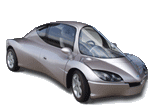


The Jetcar Technology
The goal of Jetcar Zukunftsfahrzeuge GmbH is to develop
and manufacture vehicles with cutting-edge technology and progressive designs.
As a result we have developed Jetcar 2.5 - an outstandingly
energy efficient car.
• The engine
We first of all focussed on a range of different
drives, in the case of Jetcar 2.5 the Common Rail Diesel
Engine, which is at the same time highly fuel efficient and dynamic.
All Jetcar Sport models feature a similarly efficient Otto engine. To
the greatest part, however, Jetcar's energy efficiency is related to
the construction, the chassis and the shape of the body.
While in the
development stages we experimented with various drives, for example we
tested lead-flow batteries as a possible source of energy.
Unfortunately the range of the batteries did not exceed 50 to 60
kilometers, which did not meet our expectations.
We then arranged for adapting the car to a hydrogene power cell.
But these developments were discontinued as hydrogen power cells are
not yet suitable for every day application. Once, this technology is
sufficiently progressed, however, we will include it in our concept.
Furthermore we tested a single-cylinder Diesel engine with direct
injection, which prooved unsuitable, however, due to
excessive vibrations. We pushed the development of another single-cylinder-engine,
as it is our aim to lower the consumption to 1l per 100 Km.
This altogether is the reason why we have equipped Jetcar with a three-cylinder
engine, alternatively as a Diesel-, or an Otto-engine.
• Light-weight construction
Best results in fuel – consumption are achieved by a
light-weight construction, as less weight
reduces the fuel consumption during braking and accelerating. Furthermore, we have
designed Jetcar 2.5 to be a 2-seater, which allows the car to be narrower.
The choice of construction, i.e the steel frame,
the plastic body, altogether make for much less weight.
We have also left out some aggregates in our basic version,
which again saves weight.
The model, as it is today, weighs merely 660 Kgs in
total – (driver excluded).
This light-weight construction was achieved by a spacious
profile steel frame construction, which has a double carrier
main frame located in close proximity to the seats,
which is re-inforced by a hybrid construction of glass fibre and carbon
fibre ribs extended into the roof .
This chosen type of construction for the roof including A-,
B- and C-columns has a very strong performance, particularly
where safety matters are concerned.
In addition it is very cost saving:
Two seats, one behind the other, located in the middle of the car
allow for extra safety space at the sides.
In addition the driver and the co-driver are protected by
side walls, 45 cm in height. There are crash-zones of 60 cm at the front and 50
cm at the rear.
We believe that the combination of a spacious
profile steel frame and parts made from GRP (glass-fibre reinforced plastic) and
CFP (carbon fibre reinforced plastic) offers very good pre-conditions for mainstreaming
light-weight construction in the automotive industry.
(The total weight of all parts made of GRP and CFP is approx. 90
kgs, which is only slightly heavier than the weight of reinforced
plastic parts of a common average middle-class car.)
Only the consistent application of this technology allows us
to present this highly-valuable product.
• Aerodynamics
In order to reduce the wind force it was neccessary to have
very good aerodynamics.
Especially at a speed above 100 Km/h aerodynamics have a great
influence on fuel-consumption.
The concept of our car is not to have a city-car, but to create
a vehicle that can run relatively long distances at a speed
above average. We have therefor improved aerodynamics in two
particular areas:
1. The front area
We have tried to keep the body slim in order to minimize wind exposure.
Resulting from the position of the seats (one behind the other)
known from former models such as the Messerschmidt Kabinenroller
or the famous BMW Isetta, we have reduced the front surface area to 1.3 m²
only, allowing for plenty of space within the cabin.
Jetcar 2.5 shows ideal conditions for achieving a very good drag coefficient.
The angle of the front window is quite low, the cylinder shaped cabin makes the air flow easily along the sides and the long-tailed rear allows the wind to flow
without windbreaks or whirls. In addition we kept the mud guards relatively small and covered the wheels, altogether best pre-conditions for gaining an optimum air flow.
The air inlet for the cooler has been kept quite small, yet it is very suitable, still, for engines in the range of 30 to 60 KW. A very small and
sporty front is thus created without any loss. We have subsequently covered the platform underneath and took all possible steps to create a streamlined car.
Once you realize that the power of the wind resistance increases cube in relation to the velocity you will notice the importance of our efforts towards the achievement of lower fuel consumption.
By collecting data in the wind tunnel, testing, improving, exchanging and keeping in mind the basics of wind streams and applying them to the core of our ideas and vision we created the body of Jetcar - a car, we are proud to offer: A truely innovative, progressive and future oriented car!